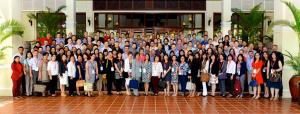The 12th Southeast Asia U.S. Agricultural Cooperators Conference in Siem Reap, Cambodia, this week brought together the region’s top buyers of oilseeds, coarse grains and co-products with several of the largest U.S. exporters.
The conference was organized by the U.S. Soybean Export Council (USSEC) and the U.S. Grains Council (USGC) and offered both a strong agenda and outstanding networking opportunities for participants.
The 170 attendees benefited from an agenda including U.S. farmer crop reports for both corn and soybeans, a global transportation outlook, review of risk management tools and information on feed sector developments.
“This conference in Southeast Asia is a great opportunity to understand what the opportunities are in this part of the world and how U.S. farmers can become a key supplier of coarse grains to this region,� said Brandon Hunnicutt a representative of the Nebraska Corn Board who delivered the U.S. corn crop report during the conference. “It also allows for great relationships to be developed that, hopefully, can pay dividends in the future.�
Southeast Asia has significant potential for increased exports with consumption of food growing at double-digit rates annually. The region’s meat production has grown from 12 million metric tons in 2004 to almost 18 million tons in 2014, a 50 percent increase. Broiler meat production doubled between 2014 and 2004, led by expansions in Indonesia, Thailand and Vietnam. The expansion of livestock production in this feed-deficient region is the primary driver of growth in the trade of coarse grains and their co-products, including distiller’s dried grains with solubles (DDGS).
“The region as a whole has a total corn demand of more than 25 million metric tons (984.2 million bushels), with an annual import demand of more than 8 million tons (315 million bushels)—most coming from Indonesia and Vietnam,� said USGC Regional Director of South and Southeast Asia Kevin Roepke.
Following the conference, USGC staff and Hunnicutt will continue an assessment mission target Southeast Asia’s demand with a tour of Myanmar.


